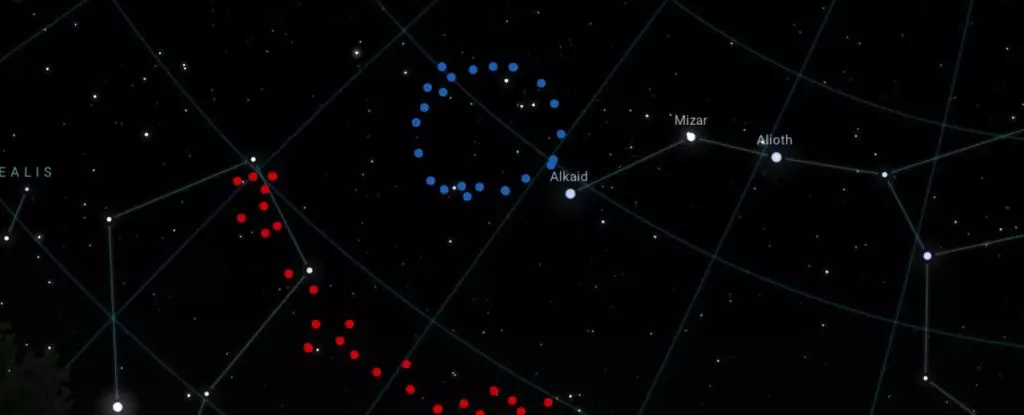The vast expanse of the universe never ceases to amaze astronomers and challenge our understanding of its evolution. In a recent discovery, astronomers have stumbled upon a colossal structure that defies our current knowledge of the cosmos. It comes in the form of an enormous ring of galaxies, stretching approximately 1.3 billion light-years in diameter. Dubbed the “Big Ring,” this mind-boggling structure has left scientists perplexed, as it does not adhere to any known structure or formation mechanism. This groundbreaking finding, presented at the 243rd meeting of the American Astronomical Society, could potentially prompt a revision of our well-established standard model of cosmology.
Astrophysicist Alexia Lopez from the University of Central Lancashire spearheads this startling breakthrough. This is not her first encounter with such enigmatic formations. Previously, she and her colleagues stumbled upon another colossal structure known as the “Giant Arc,” located in the same celestial region as the Big Ring. The discovery of the Giant Arc already left scientists puzzled, and the existence of the Big Ring only deepens this cosmic mystery. As Lopez puts it, “Neither of these two ultra-large structures is easy to explain in our current understanding of the universe.” The extraordinary sizes, distinctive shapes, and close proximity of these structures undoubtedly convey a profound message, but the true nature of this cosmic message remains elusive.
Researchers are currently exploring potential links between the Big Ring and something called a Baryon Acoustic Oscillation (BAO). BAOs are vast circular arrangements of galaxies dispersed throughout space. They represent fossilized remnants of acoustic waves that originated in the early universe but ceased to propagate as space expanded. However, the Big Ring deviates substantially from the characteristics of a typical BAO. Instead of a perfect circle, the Big Ring forms a distinctive corkscrew shape, intricately aligned to resemble a ring. This raises a pressing and unanswered question: What exactly is this enigmatic formation? Furthermore, how does it impact the Cosmological Principle, which asserts the uniformity of space regardless of direction or location?
Lopez highlights the quandary by stating, “We expect matter to be evenly distributed everywhere in space when we view the universe on a large scale, so there should be no noticeable irregularities above a certain size.” The current theoretical limit for the size of structures is approximately 1.2 billion light-years. Astonishingly, both the Giant Arc and the Big Ring surpass this limit, with the former being almost three times larger than the expected size and the latter boasting a circumference comparable to the Giant Arc’s length.
The enigmatic characteristics and colossal scale of the Big Ring pose profound questions about our current model of cosmology and the evolution of the universe. Though the existing model aligns reasonably well with observed phenomena, it struggles to explain certain peculiarities that arise within its framework. In response, alternative models have been proposed to address these challenges. One intriguing possibility is Roger Penrose’s conformal cyclic cosmology, a theory suggesting that the universe goes through endless cycles of expansion and contraction, akin to repeated Big Bangs. This particular model predicts the existence of ring-like structures, although it should be noted that conformal cyclic cosmology has its own significant unresolved issues.
Another plausible explanation for these colossal structures lies in the realm of cosmic strings, topological defects in the fabric of space-time. Cosmic strings are akin to proton-wide wrinkles that formed as space-time stretched during the early universe, subsequently becoming fixed in position. Evidence of cosmic strings remains scarce, but the theoretical basis for their existence holds promise. Currently, the true significance of the Big Ring and the Giant Arc remains an enigma longing to be unraveled. While it is plausible that these structures are simply chance configurations of galaxies suspended in space, the likelihood of such a random occurrence seems highly improbable. Perhaps the key to unlocking their mysteries lies in discovering more of these galactic arrangements hidden throughout the vastness of the universe.
The discovery of the Big Ring and the Giant Arc as colossal structures in such close proximity to one another adds an additional layer of intrigue to this cosmic enigma. As Lopez marvels, “From current cosmological theories, we didn’t think structures on this scale were possible.” Our observable universe could have conceivably contained only one exceptionally large structure. Yet, the presence of these two enormous formations as cosmological next-door neighbors presents an extraordinary and bewildering scenario that continues to captivate the scientific community.
Amidst the bewilderment and fascination sparked by the Big Ring and the Giant Arc, one thing is certain—we find ourselves on the threshold of a profound reconsideration of our current understanding of the cosmos. With ongoing research and further investigations, scientists hope to shed light on these enigmatic structures and embrace the knowledge they hold. The 243rd meeting of the American Astronomical Society served as a platform for sharing this remarkable discovery, which will undoubtedly fuel the curiosity and reverence we hold for the vast, impenetrable universe that envelops us.


Leave a Reply